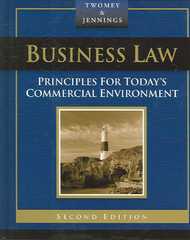Question
1: If you invest $2,000 with a 4% interest rate compounded annually, how much will you have in ten years? $2,928.20 $2,800.00 $2,960.49 $2,670.00 2:
1: If you invest $2,000 with a 4% interest rate compounded annually, how much will you have in ten years?
$2,928.20
$2,800.00
$2,960.49
$2,670.00
2: If you are going to receive $2,000 in six years from now, how much is that worth today, assuming 5% annual simple interest?
$1,780.32
$1,538.46
$1,904.76
$2,600.00
3: Which of the following options will generate the highest interest over the term, assuming the same $100 principal?
5% quarterly compounding for 3 years
5% monthly compounding for 2 years
5% simple interest rate for 3 years
5% daily compounding for 2 years
4: What's the effective rate for investment with a 6% annual rate, compounded quarterly?
6%
1.5%
6.45%
6.14%
5: Which of the following statements indicates a nominal rate of 5% annually?
5% per month, compounded daily
5% per quarter
5% per year, compounded monthly
Effective 5% per year, compounded semi-annually
6: If you need $5,000 in 4 years' time and your investment generate 6% interest per year, compounded semi-annually, how much do you need to put away today?
$4,716.98
$3,137.06
$3,960.47
$3,947.05
7: Which of the following best describes the annuity factor?
The sum of all the discount factors in each period for a fixed number of periods
The rate of return used to discount future value back to the present value
A decimal number multiplied by a cash flow value to discount it back to the present value
The expected compound annual rate of return that will be earned on a project or investment
8: What's the discount factor if you are going to receive $500 ten years from now with an 8% annual interest?
0.4632
462.96
0.93
231.60
9: Calculate the NPV of the project based on the information below:
- Initial investment: $20,000
- Cash flow generated each year: $5,000
- Total period: 5 Years
- Discount rate: 6%
(options)
$1,061.82
$2108.75
$875.43
$3,669.52
10: If a principal amount of $1,000 earns 6% per year compounded annually in the first 2 years and 3% in the last 2 years, how much will you have total at the end of year 4?
$1,193.88
$1,180.00
$1,192.03
$1,207.58
11: What do economic indicators measure?
Absolute Values, Indexes, Moving Averages
FX Rate, Monetary Policy, Foreign Policy
Volume, Value, Price
Seasonal Adjustments, Cyclical Movements, Global News
12: What are some examples of important economic events? (Select all that apply)
Consumer/Business Confidence
President's press conference on immigration
Retail & Wholesale Sales
Payroll/Unemployment Reports
Facebook announces a major acquisition
13:What are some of the duties of central banks? (Select all that apply)
Managing country's reserves
Providing research and economic indicators
Managing country's foreign relations
Regulating the bank sector
Conducting fiscal policy
14: What are SWFs commonly established from?
Individual savings accounts
Foreign currency reserve surpluses
Balance of payment deficits
Surplus from the private sector
15: Select all statements that are TRUE.
Central Banks are responsible for fiscal policy.
A lower policy rate stimulates the demand in goods, which ultimately drives up prices.
A higher policy rate will strengthen exports.
16: What is one of ECB's key policy rates?
Rate on main refinancing operations
Rate on mortgages
Rate on coupon payments
Rate on savings from individuals
17: Which one of these policies did the BoJ NOT implement in order to try to achieve the inflation target of 2%?
Fiscal Stimulus
Yield Curve Control
Negative Interest Rates
Quantitative Easing
18: How did BoJ affect prices of 10-year JGBs and maintain a yield of "around 0%"?
By decreasing interest rates to negative territory.
With adjustments to the front-end of the yield curve.
By targeting bond yields across the curve.
By increasing interest rates.
19: What category do labor market indicators fall under? (Select all that apply)
Coincident
Leading
Lagging
20: Select all statements that are FALSE.
Manufacturing orders have a shorter lead time and are not a good forecaster of output.
Consumption accounts for most of economic activity.
A PMI greater than 50 indicates a contraction in manufacturing.
21: Which option listed below is a housing sector figure?
Gross Domestic Product
Consumer Price Index
Retail sales
Building permits
22: How does an increase in the Central Bank's policy rate effect it's domestic bond market?
No change in bond prices.
A decrease in bond prices.
An increase in bond prices.
23: What are market-makers?
Entities that buy/sell securities and aim to profit from the bid-ask spread.
Companies that sell financial instruments to the buy-side.
Institutions that directly invest in financial instruments.
Individuals that trade financial instruments with company funds.
24: How do market practitioners trade economic releases? (Select all that apply)
Cash
Forwards
Other derivatives
Betting with other market practitioners on the outcome of the economic release
Step by Step Solution
There are 3 Steps involved in it
Step: 1

Get Instant Access to Expert-Tailored Solutions
See step-by-step solutions with expert insights and AI powered tools for academic success
Step: 2

Step: 3

Ace Your Homework with AI
Get the answers you need in no time with our AI-driven, step-by-step assistance
Get Started


